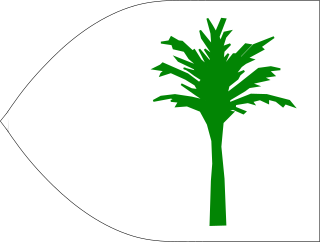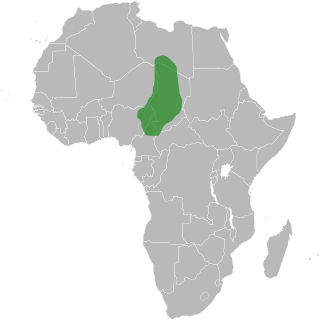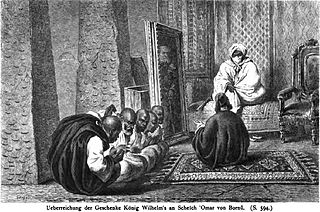Related Research Articles

Chaldea was a country that existed between the late 10th or early 9th and mid-6th centuries BC, after which the country and its people were absorbed and assimilated into Babylonia. Semitic-speaking, it was located in the marshy land of the far southeastern corner of Mesopotamia and briefly came to rule Babylon. The Hebrew Bible uses the term כשדים (Kaśdim) and this is translated as Chaldaeans in the Greek Old Testament, although there is some dispute as to whether Kasdim in fact means Chaldean or refers to the south Mesopotamian Kaldu.

The Kanem–Bornu Empire existed in areas which are now part of Chad and Nigeria. It was known to the Arabian geographers as the Kanem Empire from the 8th century AD onward and lasted as the independent kingdom of Bornu until 1900. The Kanem Empire was located in the present countries of Chad, Nigeria and Libya. At its height it encompassed an area covering not only most of Chad, but also parts of southern Libya (Fezzan) and eastern Niger, northeastern Nigeria and northern Cameroon. The Bornu Empire (1380s–1893) was a state in what is now northeastern Nigeria, in time becoming even larger than Kanem, incorporating areas that are today parts of Chad, Niger, Sudan, and Cameroon. The early history of the Empire is mainly known from the Royal Chronicle or Girgam discovered in 1851 by the German traveller Heinrich Barth.

According to the Hebrew Bible, the Kingdom of Israel, was one of two successor states to the former United Kingdom of Israel and Judah. Historians often refer to the Kingdom of Israel as the "Northern Kingdom" or as the "Kingdom of Samaria" to differentiate it from the Southern Kingdom of Judah.

Central Africa is a subregion of the African continent comprising various countries according to different definitions. Angola, Burundi, Cameroon, the Central African Republic, Chad, the Democratic Republic of the Congo, the Republic of the Congo, Equatorial Guinea, Gabon, Rwanda, and São Tomé and Príncipe are members of the Economic Community of Central African States (ECCAS). Six of those states are also members of the Economic and Monetary Community of Central Africa (CEMAC) and share a common currency, the Central African CFA franc. The African Development Bank defines Central Africa as Cameroon, the Central African Republic, Chad, the Democratic Republic of the Congo, the Republic of the Congo, Equatorial Guinea, and Gabon. Middle Africa is an analogous term used by the United Nations in its geoscheme for Africa. It includes the same countries as the African Development Bank's definition, along with Angola, and São Tomé and Príncipe.

The Songhai Empire was a state that dominated the western Sahel in the 15th and 16th century. At its peak, it was one of the largest states in African history. The state is known by its historiographical name, derived from its leading ethnic group and ruling elite, the Songhai. Sonni Ali established Gao as the capital of the empire, although a Songhai state had existed in and around Gao since the 11th century. Other important cities in the empire were Timbuktu and Djenné, conquered in 1468 and 1475 respectively, where urban-centered trade flourished. Initially, the empire was ruled by the Sonni dynasty, but it was later replaced by the Askia dynasty (1493–1591).
The Zaghawa people, also called Beri or Zakhawa, are a East African Muslim ethnic group of eastern Chad and western Sudan, including Darfur.

Sayfawa dynasty, Sefouwa, Sefawa, or Sefuwa dynasty is the name of the Muslim kings of the Kanem–Bornu Empire, centered first in Kanem in western Chad, and then, after 1380, in Borno.
Dunama Dabbalemi, or Dounama Dibbalém, of the Sayfawa dynasty, was the mai (king) of the Kanem Empire, in present-day Chad, from 1210 to 1224.
Hummay was the first Muslim king, mai, of the Sefuwa dynasty within Kanem-Bornu Empire from 1085-1097, replacing the Sefuwa-Duguwa dynasty.

The Bilala are a Muslim people that live around Lake Fitri, in the Batha Prefecture, in central Chad. The last Chadian census in 1993 stated that they numbered 136,629 persons. Their language, Naba, is divided in four dialects and is apart of the Central Sudanic language family; it is shared by two of their neighbours, the Kuka and the Medogo. These three peoples are collectively known as Lisi and are believed to be descendants of main ethnic groups of the Sultanate of Yao.
Idris Alooma, Idris ibn 'Ali (Alooma), or Idriss Alaoma, was Mai (king) of the Kanem-Bornu Empire, located mainly in Chad, Cameroon, Niger and Nigeria. His name is more properly written Idris Alawma or Idris Alauma. An outstanding statesman, under his rule Kanem-Bornu touched the zenith of its power. Idris is remembered for his military skills, administrative reforms and Islamic piety. His feats are mainly known through his chronicler Ahmad bin Fartuwa.

Umar I ibn Muhammad al-Amin or Umar of Borno was Shehu (Sheik) of the Kanem-Bornu Empire and son of Muhammad al-Amin al-Kanemi.
The Girgam is the royal chronicle of the Kanem-Bornu Empire, written in Arabic. Girgam is also used as the name for written historical records in some kingdoms west of Bornu, including Daura, Fika and Mandara, defined as "chronicle or 'list of ancestors'" or simply "date".
Long before 1500 much of modern-Nigeria was divided into states identified with contemporary ethnic groups. These early states included the Igbo Kingdom of Nri, the Benin Kingdom, Igala Kingdom, the Hausa cities, and Nupe. Additionally numerous small states to the west and south of Lake Chad were absorbed or displaced in the course of the expansion of Kanem, which was centered to the northeast of Lake Chad. Bornu, initially the western province of Kanem, became independent in the late 14th century. Other states probably existed but the absence of archaeological data prevents accurate dating. In the south, the earliest Kingdom was the Igbo Kingdom of Nri which emerged
Omar ibn Idris, or Umar Idrismi, Idris Dunama III, was the ruler of the Kanem Empire from 1372 to 1380. He moved the capital from Njimi, Kanem to Kaga, located on the western edge of Lake Chad in present day Borno State, Nigeria.

Shehu al-Hajj Muhammad al-Amîn ibn Muhammad al-Kânemî (1776–1837) was an Islamic scholar, teacher, religious and political leader who advised and eventually supplanted the Sayfawa dynasty of the Kanem-Bornu Empire. In 1846, Al-Kanemi's son Umar I ibn Muhammad al-Amin became the sole ruler of Borno, an event which marked the end of the Sayfawa dynasty's eight hundred year rule. The current Shehu of Bornu, a traditional ruler whose seat remains in modern Borno State, Nigeria, is descended from Al-Kanemi.
The Qedarite Kingdom, or Qedar, was a largely nomadic, ancient Arab tribal confederation. Described as "the most organized of the Northern Arabian tribes", at the peak of its power in the 6th century BCE it had a kingdom and controlled a vast region in Arabia.

The Twenty-fifth Dynasty of Egypt, also known as the Nubian Dynasty or the Kushite Empire, was the last dynasty of the Third Intermediate Period of Egypt that occurred after the Nubian invasion.

The Early Period refers to the history of Assyrian civilization of Mesopotamia between 2500 BCE and 2025 BCE. It is the first of the four periods into which the history of the Assyrian civilisation is traditionally divided. The other periods are the Old Assyrian Empire, the Middle Assyrian Empire and the Neo-Assyrian Empire.
The House of Jehu or Jehu dynasty was a reigning dynasty of the Kingdom of Israel. They are depicted in both of the Books of Kings. Their estimated reign is placed from the 9th century to the 8th century BCE.
References
- 1 2 Urvoy, Y. (1949). Historie De L'Empire Du Bronu (Memoires De L'Institut Francais D'Afrique Noire, No. 7 ed.). Paris: Librairie Larose. p. 26.
- ↑ Smith: Early states, 167.
- 1 2 Palmer, Richmond (1936). The Bornu Sahara and Sudan. London: John Murray. pp. 9, 38, 118, 180.
- ↑ Lange: Founding of Kanem, 13-18.
- ↑ Urvoy, Empire, 26.